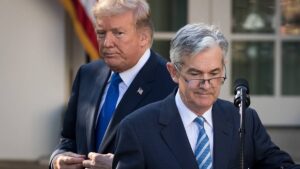Think Big: Could negative interest rates become a reality in Australia?

Westpac's economics team has raised the prospect that negative interest rates could become part of the policy discussion next year. (Pic: Getty Images)
As the Australian economy embarks on a tricky pathway to recovery, it makes for an interesting debate about what policy makers should do next to support growth.
That’s particularly so for interest rates, where the RBA accelerated its long-term rate-cutting cycle to an end point in March by slashing rates to new all-time lows of 0.25 per cent.
At the same time, the central bank’s latest forecasts show it expects GDP growth and inflation to remain subdued for the medium term.
That outlook has been accompanied by a unique shift (at least in Australian economic history), in that the prospect of negative interest rates has now been tabled for discussion.
Keep an eye on the AUD
For his part, RBA governor Philip Lowe has been fairly adamant that won’t happen.
As recently as last week, Lowe told a parliamentary committee that negative rates are still “extraordinarily unlikely” in the scheme of things.
(He’s also consistently advocated for fiscal stimulus to play a more central role, in addition to the RBA’s own support measures).
Conversely, Westpac chief economist Bill Evans has extolled some of the benefits of negative rates, as Australia looks to remain competitive in a post-COVID world.
In a report last week, he analysed Lowe’s responses to the negative rates question in connection with Westpac’s own outlook for economic growth and the Australian dollar.
On that front, Westpac is of the view that the Australian dollar has now entered “a long upswing period”, which it expects to continue at least until the end of next year.
And as a “small open economy with large foreign liabilities”, Evans said Australia was “likely to benefit through negative rates with a lower exchange rate”.
The mechanics of negative rates
Broadly speaking, that’s a view shared by the RBA governor as well. However, Evans said Lowe’s main concern appeared to centre around how negative rates would affect domestic consumption.
Specifically, his view of Lowe’s position was that “if the deposit rate was negative, people would save more than spend on the basis that expected income growth would be negative”.
But while Evans acknowledged that introducing negative rates for the first time would be accompanied by a degree of uncertainty, he said Australia was relatively well-placed to weather a demand-side impact.
For starters, he noted that retail deposits only represented around 60 per cent of the assets in Australia’s banking system.
That compares favourably to other countries that have implemented negative rates such as Japan and Switzerland, where the retail saving component is closer to 100 per cent.
And at the same time, negative rates may push corporate and institutional capital into higher yielding investments that boost economic growth, or offshore activities which will help put downward pressure on the exchange rate.
Fundamentally, Westpac reckons the introduction of negative rates will lower the fair value of the Australian dollar.
And that’s accompanied by the view that Australia’s economy will only return to 3 per cent growth next year – well below the RBA’s 5 per cent estimate.
In other words, with the growth picture complicated by a rising Aussie dollar, more accommodative policy settings may still be required.
“Perhaps, under such circumstances, in 2021 the negative interest rate/intervention debate might get a wider hearing,” Evans said.
The Westpac view forms part of the broader economic debate currently taking place about the best way to recover the growth lost to the pandemic.
Last week, Commonwealth Bank senior economist Gareth Aird said interest rates were expected to stay low for “many, many years”.
He added that at some point in the future, the conversation would “inevitably shift” towards increased cooperation between fiscal and monetary policymakers, where government spending was financed by direct injections of capital by the RBA.
Related Topics
UNLOCK INSIGHTS
Discover the untold stories of emerging ASX stocks.
Daily news and expert analysis, it's free to subscribe.
By proceeding, you confirm you understand that we handle personal information in accordance with our Privacy Policy.








